ERA Country Report 2023
Lithuania
Edited by Jonas Antanavičius (Visionary Analytics)
as part of ‘Development of the ERA Scoreboard, the ERA Dashboard and the Regular Reports’ project for the European Commission, Directorate-General for Research and Innovation under Framework Contract N° 2018/RTD/A2/OP/PP-07001-2018 Lot 2 (EDAR)
Click here to download this country report![]()
- Table of contents
-
ERA Country Report 2023: Lithuania
1. National context
1.1. Overview of the ERA policy agenda implementation
1.2. Policy context
2. Assessment of the Implementation of the ERA Policy Agenda and ERA Priorities
2.1. ERA Priority 1: Deepening a truly functional internal market for knowledge
2.2. ERA Priority 2: Taking up together the challenges posed by the twin green and digital transition and increasing society’s participation in the ERA
2.3. ERA Priority 3: Amplifying access to research and innovation excellence across the Union
2.4. ERA Priority 4: Advancing concerted research and innovation investments and reforms
3. Country-specific drivers and barriers
4. Final remarks
5. Bibliography
6. Annexes
6.1. Annex 1: Graphs
ERA Country Report 2023: Lithuania
|
Key takeaways:
|
1. National context
1.1. Overview of the ERA policy agenda implementation
According to the 2023 European Innovation Scoreboard (EIS), Lithuania, classified as a Moderate Innovator, is performing at 83.8% of the EU average, below the mean for its category. ^ Nevertheless, there is a notable (27%) improvement in its performance since 2016. This is mainly due to increased venture capital and non-R&D innovation spending.
Lithuania’s support to the ERA Policy Agenda is evident: the country has committed to 14 actions. The main strategy for research and innovation (R&I) development in Lithuania is the Research Development Programme for 2022-2030 (RDP). The programme consists of three progress measures: strengthening innovation ecosystems in science centres; improving the research and higher education environment; and implementing mission-based research and innovation programmes. The implementation of RDP is supported by a variety of funding sources, including national funding, European structural and investment funds (ESIF), REACT-EU, and the Recovery and Resilience Facility (RRF). Many measures from the previous investment period (2014-2020) are being continued to ensure the continuity of actions and a smooth transition to the implementation of the RDP.
1.2. Policy context
The Ministry of Education, Science and Sport is the main public body for the R&I policy development in the ERA context. After the dissolution of the Agency for Science, Innovation and Technology in 2022, the main institution responsible for the implementation of R&I policy in Lithuania is the Research Council of Lithuania (Lietuvos mokslo taryba - LMT). ^ The Ministry of Economy and Innovation is responsible for R&I policy targeting private business sector innovation. In 2022, the Ministry of Economy and Innovation merged different agencies into the Innovation Agency which promotes and supports innovations at all stages of business development.
The Lithuania 2030 progress strategy (2012) is the main document that defines the long-term vision and priorities for Lithuania’s development. ^ The National Progress Plan for 2021-2030 (NPP) is the operational document that translates this long-term strategy and allows to manage the achievement of strategic goals for all policy fields (including R&D). In line with these documents, the previously mentioned RDP was adopted in 2022. ^ It is a key instrument for implementing the R&D policy in Lithuania and ERA policy is an integral part of RDP.
In addition, the Education Development Programme for 2022-2030 and the Economic Transformation and Competitiveness Development Programme for 2022-2030 are two sectoral programmes under the NPP that support the R&I policy in Lithuania. The former aims to enhance the quality and accessibility of education, the human capital and the research potential of the education system. The latter aims to promote economic transformation and innovation, as well as cooperation between the public and private sectors, and academia.
Under RDP, Lithuania is implementing various measures in line with ERA Policy Actions. For example, as part of the RRF plan “New Generation Lithuania”, a measure “Support for activities aimed at implementing ERA priorities for institutional change” promotes the implementation of ERA Actions 3, 4, 5, 9 and 14 ^ in universities and research institutions. ^ In addition, the new concept for smart specialisation (2021-2027) is aimed to strengthen R&I capacities, develop new technologies, and increase the country's competitiveness in global markets. ^ The discussed policy initiatives (see Chapter 2) and a new smart specialisation strategy concentrate resources in the areas of the highest growth potential.
Overall, the National Agreement on Education Policy (2021-2030) between political parties in the Parliament mandates that by 2030 the state budget allocations for R&D (GBARD) should reach at least 1% of the GDP. This parliamentary agreement ensures the implementation of this obligation despite possible changes of the majority in Parliament.
2. Assessment of the Implementation of the ERA Policy Agenda and ERA Priorities
Chapter 2 has two objectives: 1) It qualitatively assesses the state-of-play of the implementation of the ERA actions that Lithuania has committed to. The qualitative information stems from the OECD STIP survey 2023 and additional desk research; 2) It quantitatively assesses the country’s progress towards achieving the ERA priorities as set out on the Pact for Research and Innovation in Europe. The presented quantitative information is mainly based on the ERA Scoreboard and ERA Dashboard indicators and covers longer-term trends since 2010. Additionally, general indicators for the overall R&I system are outlined in Table 1. More detailed information on the data and graphs can be found in Annex 1. This report will serve as a baseline for reporting in the future.
|
Indicator |
Most recent EU average |
Most Recent Metric |
|
Gross Domestic Expenditure on R&D (GERD) as a percentage of GDP |
2.26 (2021) |
1.11 (2021) |
|
Government Budget Allocations for R&D (GBARD) as a share of GDP |
0.76 (2021) |
0.31 (2021) |
|
Researchers (in full-time equivalent) per million inhabitants |
4,483.4 (2021) |
3,940.7 (2021) |
|
Business Enterprise expenditure on R&D (BERD) as a percentage of GDP |
1.49 (2021) |
0.5 (2021) |
Source: compiled by research team based on the ERA Scoreboard and ERA Dashboard indicators
2.1. ERA Priority 1: Deepening a truly functional internal market for knowledge
2.1.1. State of play in the implementation of the ERA Actions
In terms of ERA Action 1: Enable Open Science, including through the European Open Science Cloud (EOSC), the Consortium of the Lithuanian Academic Electronic Library (eLABa) is the most notable initiative in Lithuania in terms of open science. eLABa provides open-access database service for various e-documents as described in the Lithuanian Research and Study Informational Infrastructure Development Program for the years 2021-2024. In addition, the Open R&D Lithuania network unites open-access R&D centres of Lithuanian universities, public research institutes and technology parks.
Additional policies related to open science are included in Lithuania’s response to the EOSC survey, such as the Economic Revival and Resilience Building Plan “New Generation Lithuania”. In its response, Lithuania also indicated that it covers the provision of making FAIR data searchable with the EOSC and the FAIRisation of data in the funding it provides; however, they have not yet appointed a Mandated Organisation to the EOSC Association.
Lithuania has also committed to ERA Action 3: Reform the Assessment System for research, researchers and institutions, which is acknowledged in the recent measure “Support for activities aimed at implementing ERA priorities for institutional change”. ^ This financial measure, provided by RRF and the national Lithuanian budget, is dedicated to institutional change: a university or research institute may use the grant to prepare necessary changes to implement no less than one ERA Action (action 3, 4, 5, 9 or 14).
As for ERA Action 4: Promote attractive research careers, talent circulation and mobility, in 2022, legal changes to the law on research and studies on the regulation of researchers' careers introduced four profiles of the research career (following the provisions of the European framework for research careers and ERA practice) as well as setting their interconnections with the posts of research and academic positions. ^ The Horizon Europe acceleration programme (under the RDP progress measure of strengthening innovation ecosystems in science centres) aims to strengthen the competencies of representatives from research, business and public sectors to enhance participation in the open calls of the Horizon Europe programme.
The goal of ERA Action 5: Promote gender equality and foster inclusiveness is deeply rooted in the Lithuanian legal framework, ^ and the National Progress Plan for 2021-2030 (NPP) further highlights such equality principles. However, gender aspects are not specifically included in the implementation objectives. The sole document focused on R&I institutions is “Recommendations to Ensure Equal Opportunities for Women and Men in Research and Higher Education Institutions” (2014), which identifies key directions to implement gender equality principles. ^ In addition, many higher education institutions (HEIs) in Lithuania have introduced Gender Equality Plans (GEPs), which is one of the Horizon Europe eligibility criteria.
Regarding ERA Action 6: Protect academic freedom in Europe, academic freedom is one of the fundamental values of democracy, which is, therefore, reflected in the principles of national law on higher education and research (Article 3). Regarding relevant recent initiatives, the government has taken measures to support students and vulnerable groups during the COVID-19 pandemic and ensure equal opportunities. ^
As for ERA Action 7: Upgrade EU guidance for a better knowledge valorisation, the financial instrument Early Stage and Development Fund I is intended to promote the commercialisation of ideas generated in HEIs and research institutions and ensure greater availability of capital to micro, small and medium-sized enterprises developing products in high-technology sectors. ^ The plan "New Generation Lithuania" includes a wide range of measures aimed at strengthening the start-up ecosystem, such as improving the business acceleration system and expanding the Fund for the Promotion of Innovation by increasing the availability of financing for business investments in R&I.
In relation to ERA Action 8: Strengthen sustainability, accessibility and resilience of research infrastructures in the ERA, the action plan of the 18th Government program ^ includes relevant initiatives. For example, the Lithuanian Research and Study Informational Infrastructure Development Program for the years 2021-2024 provisions the enhancement of an open-access research infrastructure. Another initiative under this Government program is the participation in the European Grid Infrastructure (EGI) Federation, an international e-infrastructure providing advanced computing and data analytics for R&I. ^
Lastly, the aim of ERA Action 9: Promote a positive environment and level playing field for international cooperation based on reciprocity is likewise one of the strategic goals envisioned in the RDP plan. The Research Council of Lithuania and its subsidiary body established in 2017, the Lithuanian Research Development and Innovation Liaison Office in Brussels (LINO), are responsible for strengthening European research cooperation and facilitating the successful integration of Lithuanian researchers into international research projects.
2.1.2. Progress towards achieving ERA Priorities
In the promotion of Sub-priority 1.1: Open Science, Lithuania is above the EU-27 average in terms of the share of publications available in open access (Figure 5 in Annex 1). Compared to 2009, an increase of 4 percentage points in such publications was observed in 2019, when the share was around 44% (while the EU average was 39%). However, one study found that theses and dissertations are the majority of eLABa entries ^ , thus, significantly contributing to the higher share of open-access publications in Lithuania.
With regards to Sub-priority 1.2: Research infrastructures, the progress towards this can be reflected by the number of European research infrastructures in which a country financially contributes to operations (Figure 6 in Annex 1). In 2021, compared to the EU-27 average Lithuania participated in four times less research infrastructures (4 vs. 16), suggesting that Lithuania should focus development in this area.
In relation to Sub-priority 1.3: Gender equality, equal opportunities for all and inclusiveness, the selected indicators suggest that the situation in Lithuania is relatively good compared to the EU-27 average. The share of women in grade A positions in higher education institutions (HEIs) stood at around 40% from 2010 to 2018 (the latest available year) while the EU-27 average rose to 27.2% starting from 22.3% in 2010 (Figure 7 in Annex 1).
Figure 8 in Annex 1 depicts the proportion of women among doctoral graduates in narrow fields of Science, Technology, Engineering and Mathematics (STEM), which has recently decreased from 47.9% (2019) to 42.6% (2020). Although, this is still above the EU-27 average of 37.4% (2020). Positive trends are also seen in the proportion of women in authorships of the 10% most cited publications (Figure 10 in Annex 1). In 2010-2018, this share increased from 31.7% to 44.8% in Lithuania, whereas the respective values for the EU-27 average are 28% and 32.6%.
On the other hand, the proportion of papers with mixed-gender authorship (Figure 9 in Annex 1) in Lithuania is lagging behind the EU-27 average (56.6% vs. 62.7% in 2020). Yet, a significant increase has been observed in Lithuania since 2010 when the proportion was 40.7%. As for the Women in Digital Index in 2022 (Figure 11 in Annex 1), Lithuania’s score (52.3) is also lower than the EU-27 average (54.9). Thus, despite the generally well-balanced gender dimension in research, there is still some room for improvement in Lithuania.
As for Sub-priority 1.4: Researchers’ careers and mobility and research assessment and reward systems, one of the indicators reflecting the progress is the job-to-job mobility of Human Resources in Science and Technology (HRST) (Figure 14 in Annex 1). The graph shows that in 2010-2020 Lithuania was above the EU-27 average: starting from 7.7 points in 2010 and reaching 10.8 in 2020.
The share of foreign doctorate students as a percentage of all doctorate students (Figure 12 in Annex 1) has been lower compared to the EU-27 average. For example, in 2021, the share of foreign doctorate students in Lithuania was almost four times smaller than the EU-27 average (6.6% vs. 23.3%). Moreover, the share of new doctorate graduates per 1,000 inhabitants aged 25-34 (Figure 13 in Annex 1) remained steady in 2013–2021 (around 0.4‰-0.5‰). This, however, stands below the EU-27 average, which was 0.8‰ in 2021. Considering this, there is a need for specific measures to create an attractive environment for foreign doctorate students in Lithuania.
On Sub-priority 1.5: Knowledge valorisation, Lithuania has made strides in fostering public-private collaborations in research. The share of public-private co-publications per million population (Figure 15 in Annex 1) in Lithuania steeply increased from about 34.1 in 2011 to 96.6 in 2021. Yet a significant gap remains compared to the EU-27 average (133.9 in 2021). In terms of the number of PCT patent applications divided by GDP in million euros (Figure 16 in Annex 1), Lithuania stands significantly below the EU-27 average. For example, in 2015 (latest available data) the value for Lithuania was approx. 0.0002 while the EU-27 average was more than ten times higher (approx. 0.0023).
A big gap is likewise observed in Figures 17 and 18 in Annex 1, illustrating business enterprise researchers as a percentage of national researchers and business enterprise researchers in full-time equivalent per thousand employees in industry – both values for Lithuania in 2020 were around two times smaller than the EU-27 average. As for the share of innovating firms collaborating with HEIs or public/private research institutions (Figure 19 in Annex 1), Lithuania is more in line with the EU-27 average (approx. 11.7% vs. 13.3% in 2020). Combined, these data suggest that the science-business link in Lithuania is rather weak.
However, some of the programmes and initiatives in Lithuania are selected as best practices for knowledge valorisation in the EU. The cooperation between Kaunas University of Technology and the Lithuanian Engineering Industries Association (LINPRA) serves as a good example of the bi-directional mobility of knowledge between engineering industries and academia. ^ The university and LINPRA collaborate to foster science-business partnerships, innovation and entrepreneurship through various activities and programs.
In relation to Sub-priority 1.6: Scientific leadership, Figure 21 in Annex 1 depicts the Academic Freedom Index (2010-2022) which measured at 0.92 in 2022 in Lithuania (vs. 0.82 in EU-27). Another relevant indicator shows the number of scientific publications among the top 10% of most cited publications worldwide as a percentage of all publications (Figure 20 in Annex 1). Here, on the contrary, Lithuania is below the EU-27 average (which stood at around 10% since 2010). However, almost a two-fold increase is observed in Lithuania, starting from 3.3% in 2010 and reaching 5.9% in 2020, suggesting that the gap could be narrowed down in the near future.
Lastly, concerning Sub-priority 1.7: Global engagement, international co-publications with non-EU partners per 1,000 researchers in the public sector (Figure 22 in Annex 1) shows remarkable progress in Lithuania and the EU. In 2010 the number of international co-publications in Lithuania was lower than the EU-27 average (approx. 255 vs. 660), however, in 2021 the gap has reduced slightly (approx. 922 vs. 1279).
In terms of European and international co-patenting in EPO applications at the national and EU level (Figure 23 in Annex 1), the latest available data from 2013 shows 18 applications submitted for Lithuania, while the EU-27 average was 80 times higher (around 1461). This suggests that despite Lithuania’s relatively good performance in international co-publications, the commercialisation of research outputs needs improvements.
2.2. ERA Priority 2: Taking up together the challenges posed by the twin green and digital transition and increasing society’s participation in the ERA
2.2.1. State of play in the implementation of the ERA Actions
The first action under this priority is ERA Action 10: Make EU research and innovation missions and partnerships key contributors to the ERA. RDP 2022-2030 ^ introduced a measure for implementing mission-based R&I programmes, which resulted in the creation of three consortia of HEIs directed towards tackling challenge-based issues in the missions of safe and inclusive e-society, smart and climate-neutral Lithuania, and innovation for health. ^ The Horizon Europe acceleration programme aims to increase the participation of Lithuania in the Horizon Europe programme.
In terms of ERA Action 11: An ERA for green transformation, Lithuania has been prioritising this area as it is in line with the strategic goal of energy security and independence. The National Energy Independence Strategy, among other aims related to energy independence, underlines the importance of energy innovation to support green transition.
The corresponding Action Plan for Strengthening the Lithuanian Energy Innovation Ecosystem sets out specific measures to develop the energy innovation ecosystem in funding, human resources, infrastructure, products and services, science and technology, the regulatory environment, consumers, and communication for the 2020-2030 period. One of the main areas of focus in Lithuania is hydrogen technologies. For this purpose, in 2020, the Lithuanian Hydrogen Platform was created to promote cooperation in the creation and development of hydrogen technologies.
As for ERA Action 12: Accelerate the green/digital transition of Europe’s key industrial ecosystems, the new smart specialisation programme promotes R&I and competitiveness in various industries, including energy and information and communication technologies (ICT) sectors. ^ Moreover, the Industry 4.0 Platform (Pramonė 4.0), established in 2016, unites major stakeholders of the industrial ecosystem for the common goal of digitisation. ^ One of the platform’s results is the Lithuanian Industry Digitisation Roadmap 2020-2030, which provides measures for strengthening the local industry digitisation ecosystem.
Concerning ERA Action 13: Empower Higher Education Institutions, a recent measure “Support for activities aimed at implementing ERA priorities for institutional change” is dedicated to institutional change. A related financial instrument is “University Excellency Initiative” (EUR 56.7 million) under the NPP progress measure “Improving the science and study environment”. ^ It aims to strengthen the quality of R&D of Lithuanian universities in selected directions by attracting and educating researchers, increasing the number of high-level scientific (artistic) results of national and international importance, and attracting external R&D funding. Moreover, another measure “To create conditions for high-quality, international and accessible studies” seeks to strengthen the international competitiveness of higher education institutions and integrate foreign students.
The last action under ERA Priority Area 2 is ERA Action 14: Bring Science closer to citizens. In relation to this, the CS4Welfare project, implemented in Lithuania (2020-2021), developed recommendations for governmental institutions and other stakeholder groups on engaging citizens through citizen science. ^
2.2.2. Progress towards achieving ERA Priorities
In relation to Sub-priority 2.1: Challenge-based ERA actions, Lithuania’s performance is relatively low. Lithuania's GBARD allocated to Europewide transnational, bilateral or multilateral, public R&D programmes per FTE researcher in the public sector (Figure 25 in Annex 1) is highly lagging behind the EU-27 average (approx. EUR 507 vs. EUR 1789 in 2020). However, a four-fold increase is visible in Lithuania compared to 2019 when the value stood at around EUR 125.
Similar trends are observed looking at Government Budget Allocations for R&D (GBARD) by NABS in energy; environment; transport, and telecommunications and other infrastructure (Figure 24 in Annex 1). The graph shows that for all three types of infrastructure, Lithuania allocates more than 20 times less national budget compared to the EU-27 average. The budget provisions for challenge-based EU R&I Missions and Partnerships remain extremely low and this hinders Lithuania’s progress towards achieving ERA objectives.
Another relevant indicator is the environmentally related government R&D budget as a percentage of total government R&D (Figure 26 in Annex 1). Although in 2010-2011 the gap between Lithuania and the EU-27 average was relatively small (around 2% vs. 2.8% for the EU-27), since 2012 the value in Lithuania plummeted to practically zero (around 0.5%). This trend remained similar until 2020 (latest year) with an exception in 2015 (2.1%).
Lithuania's progress in green transition can be reflected by national public and private investments as suggested in the European Strategic Energy Technology (SET) Plan progress report 2021 (Figure 27 in Annex 1). The indicator shows that Lithuania is noticeably below the EU average even though it has increased since 2010. Whereas regarding OECD patents on environment technologies (Figure 28 in Annex 1) both Lithuania’s measure and the EU-27 average have declined in the past decade. Starting at 28.6% in 2010 (vs.14.1% EU-27 average), the share of such patents in Lithuania fluctuated before falling to its minimum of 6.9% in 2019. This is below the last available EU-27 average of 12.9% (in 2018).
As for Sub-priority 2.2: Synergies with education and the European Skills Agenda, some improvements are observed in Lithuania. The share of researchers receiving transferable skills training (Figure 29 in Annex 1) provides insights into the promotion of relevant skills among researchers in HEIs. In 2019, this proportion of researchers in Lithuania was practically identical to the EU-27 average (46.5% vs. 46.3%). This marks a slight increase compared to 2016 when the respective value in Lithuania measured at 45.3%, whereas the EU-27 average was 49.5%.
With regards to Sub-priority 2.3: Synergies with sectorial policies and industrial policy, in order to boost innovation ecosystems, looking at the direct government support and indirect government support through R&D tax incentives as a percentage of GDP (Figure 30 in Annex 1), Lithuania is performing poorly compared to the EU-27 average. Over the past decade (2010-2020) the share of government support in Lithuania was around 0.02-0.03%, while the EU-27 average was more than six times higher (around 0.15-0.18%). Therefore, in order to make progress in the challenge-based ERA Actions, Lithuania needs to prioritise more investments and support related to the environment.
Lastly, in relation to Sub-priority 2.4: An active citizen and societal engagement in R&I in all its dimensions, Trust in Science reveals that 56.9% of Lithuanians strongly trusted science in 2021, whereas the EU-27 average was only 43.2% (Figure 31 in Annex 1). In addition, the number of publications on “social innovation” or “social entrepreneurship” per million population (Figure 32 in Annex 1) reveals some positive trends in Lithuania. A significant rise in Lithuania was observed in 2013-2016, starting from approx. 1.7 publications per million population to approx. 7.9. However, the number has decreased since 2017 and eventually levelled off to roughly 2.5 in 2019-2022. Meanwhile, the EU-27 average has risen incrementally from approx. 0.3 in 2010 to 1.8 in 2021 but decreased to around 1 in 2022. Hence, the situation in Lithuania is relatively good in terms of citizen science when compared to the EU-27 average.
2.3. ERA Priority 3: Amplifying access to research and innovation excellence across the Union
2.3.1. State of play in the implementation of the ERA Actions
Under ERA Priority Area 3 Lithuania has committed to ERA Action 16: Improve EU-wide access to excellence. The RDP progress measure "Strengthen innovation ecosystems in science centres" includes a set of particular activities (financial measures) for promoting internationalisation, commercialisation and the overall excellence of science in Lithuania.
In addition, although Lithuania has not officially committed to ERA Action 17: Enhance public research institutions’ strategic capacity, some national initiatives support this action. For example, the aforementioned Horizon Europe acceleration programme seeks to enhance the participation of research institutions in the Horizon Europe programme. ^ Furthermore, the Education Development Programme’s progress measure “Ensure effective management of the higher education and research system” aims to bolster strategic management capabilities and operational efficiency of higher education and research institutions.
2.3.2. Progress towards achieving ERA Priorities
Lithuania’s progress towards Sub-priority 3.1: More investments and reforms in countries and regions with lower R&I performance is dependent on the overall level of investment. Between 2017 and 2019 the increase (in percentage points) of total R&D expenditure expressed as a percentage of GDP (Figure 33 in Annex 1) in Lithuania was similar to the EU-27 average of around 0.04%. Lithuania showed a record-high increase of 0.15% in 2020 (vs. EU-27 average of 0.08%) before plunging to a decrease of 0.02% in 2021. Nevertheless, the situation is still slightly milder compared to the decrease of EU-27 average of 0.04% in 2021. This fall can be explained by the GDP rebound in 2021 after the significant drop in 2020 because of the COVID-19 pandemic. ^
2.4. ERA Priority 4: Advancing concerted research and innovation investments and reforms
2.4.1. Progress towards achieving ERA Priorities
Although Lithuania has not committed to any action under ERA Priority Area 4, an indicator under Sub-priority 4.1: Coordination of R&I investments can provide insights into Lithuania’s progress. The share of public R&D expenditures financed by the private sector (Figure 34 in Annex 1) reveals that Lithuania was performing significantly above the EU-27 average from 2010 to 2016 (measuring around 12-15%) and eventually equalled the EU-27 average in 2018-2020 at about 8%. This shows that the coordination of R&I investments in Lithuania is satisfactory.
Summing up the overall state of R&I in Lithuania, in approximately half of the indicators country’s performance is significantly below the EU-27 average, especially concerning government budget allocations for R&D (GBARD) in challenge-based areas (green and digital transition). However, Lithuania’s commitment and efforts to enhance the R&I ecosystem are reflected in the recent strategic documents and initiatives, such as the RDP plan and the new smart specialisation concept. In the other half of the indicators, Lithuania is above or in line with the EU-27 average, for example, in terms of researchers’ careers and mobility, as well as citizen science.
3. Country-specific drivers and barriers
The recent Lithuanian R&I strategy underpins the implementation of the ERA Policy Agenda. The RDP strategy supports the development of the R&I system in Lithuania by provisioning the promotion of knowledge-intensive businesses, support for the science-business collaboration, and commercialisation of research in HEIs and research institutions. It formulates specific progress measures, such as improving the science and study environment, strengthening innovation ecosystems in research centres, and implementing mission-based science and innovation programmes.
The recent creation of a single Innovation Agency for business and centralised implementation of research policy by the Research Council of Lithuania contribute to the coordination of the R&I system. ^ In addition, this integrity is increased with the establishment of different advisory bodies, such as the Strategic Council for Science Technology and Innovations, and the establishment of science and innovation advisor positions in each ministry and Government Office. ^ According to the European Semester Report (2023), a new smart specialisation strategy, overseen by the governmental Coordination Group, ^ helps to concentrate resources in the areas of the highest growth potential. ^ This further contributes to the integration into international networks to create more impact.
Lithuania faces some barriers that hinder progress in research and innovation. First of all, the overall investments in R&D are significantly lagging behind the EU-27 average. The European Semester Report highlights that most of the R&D investment is funded by the government, yet R&D intensity remains considerably below the government's aim of 1.5% of GDP by 2025, ^ whereas the private sector does not perceive innovation as a critical factor to long-term competitiveness. This leads to limited capacities to absorb public R&D investments without simultaneously dealing with capacity building. ^
Furthermore, Lithuania faces difficulties in attracting foreign researchers. This is associated with a certain administrative burden to employ foreigners. ^ The brain drain of highly skilled researchers is a significant issue impacting the growth of R&D activities in Lithuania. ^ In addition, while science-business linkage is high on the policy agenda, there is still room for improvement. There are few overall incentives for innovative enterprises to work with public research organisations. Yet, as noted in the European Semester Report, the start-up ecosystem is relatively advanced in Lithuania. ^
4. Final remarks
Lithuania’s support of the ERA Policy Agenda is evident as it has committed to 14 ERA Actions. Its national strategic documents and specific measures support the implementation of ERA priorities. Lithuania has been focusing on the development of R&I in the areas of the highest growth potential, namely energy and material technology, biotechnology, and information and communication technologies.
This is reflected in the new smart specialisation concept, which seeks to strengthen R&I capacities, develop new technologies, and increase the country's competitiveness in global markets. In addition, numerous measures were taken recently to enhance science-business linkage and promote the commercialisation of research by supporting the start-up ecosystem.
The indicators where Lithuania shows the best performance are connected to researchers’ careers and mobility and citizen science. On the other hand, the government budget allocations for R&D (GBARD) in challenge-based areas (green and digital transition) are significantly below the EU-27 average. This includes GBARD allocated to international R&D programmes and missions in different industries (according to NABS).
Therefore, one of the main challenges for R&D in Lithuania is posed by the general funding capacity. Lithuania would benefit from providing more long-term public R&D financing and combining research resources, as well as encouraging private R&D investment and enhancing national policies to attract and retain talent. Consequently, the National Agreement on Education Policy (2021-2030) between political parties in the Parliament supports this goal.
5. Bibliography
‘Agreement on National Education Policy (2021-2030)’, Ministry of Education, Science and Sport website, https://smsm.lrv.lt/en/legal-information/agreement-on-national-education-policy-2021-2030
‘Atrinkti trys konsorciumai, kurie įgyvendins misijomis grįstas mokslo ir inovacijų programas’, Ministry of Economy and Innovation website, available at https://eimin.lrv.lt/lt/naujienos/atrinkti-trys-konsorciumai-kurie-igyvendins-misijomis-gristas-mokslo-ir-inovaciju-programas
‘Early Stage and Development Fund I’ (Ankstyvosios stadijos ir plėtros fondas I). OECD STIP. https://stip.oecd.org/stip/interactive-dashboards/policy-initiatives/2023%2Fdata%2FpolicyInitiatives%2F99996921
‘Early Stage and Development Fund I’, Invega website, available at https://invega.lt/en/business/business-start/venture-capital/170/early-stage-and-development-fund-i-48
‘EU investment in R&D increased to €328 billion in 2021’, Eurostat website, available at https://ec.europa.eu/eurostat/web/products-eurostat-news/w/ddn-20221129-1
‘Hydrogen platform being developed in Lithuania to promote advanced energy technologies’, Ministry of Energy website, available at https://enmin.lrv.lt/en/news/hydrogen-platform-being-developed-in-lithuania-to-promote-advanced-energy-technologies
‘Kvietimas teikti programos „Universitetų ekscelencijos iniciatyvos“ projektų įgyvendinimo planus’, Ministry of Education, Science and Sport website, https://smsm.lrv.lt/lt/veiklos-sritys-1/mokslas/universitetu-ekscelencijos-iniciatyva/
‘Lithuania. Promoting gender equality in research’, EIGE website, available at https://eige.europa.eu/gender-mainstreaming/toolkits/gear/legislative-policy-backgrounds/lithuania?language_content_entity=en
‘Nacionalinė pramonės skaitmeninimo platforma Pramonė 4.0’, Ministry of Economy and Innovation website, available at https://eimin.lrv.lt/lt/veiklos-sritys/verslo-aplinka/pramone/pramone-4-0/nacionaline-pramones-skaitmeninimo-platforma-pramone-4-0
Butkevičienė, E. et al. (2021). Piliečių Mokslas Kaip Inovatyvi Piliečių Dalyvavimo Forma Kuriant Gerovės Visuomenę: Monografija; KTU leidykla “Technologija”: Kaunas, Lithuania. Available at https://ebooks.ktu.edu/pdfreader/piliei-mokslas-kaip-inovatyvi-dalyvavimo-forma-kuriant-gerovs-visuomen
Central Project Management Agency and Ministry of Education, Science and Sport. (2023). Support for activities aimed at implementing ERA priorities for institutional change (Parama veikloms, skirtoms Europos mokslinių tyrimų erdvės prioritetams įgyvendinti, siekiant institucinių pokyčių). Available at https://2021.esinvesticijos.lt/kvietimai/parama-veikloms-skirtoms-europos-moksliniu-tyrimu-erdves-prioritetams-igyvendinti-siekiant-instituciniu-pokyciu
Economic Recovery and Resilience Facility plan “New Generation Lithuania” (Ekonomikos gaivinimo ir atsparumo didinimo planas “Naujos kartos Lietuva”). Available at https://finmin.lrv.lt/uploads/finmin/documents/files/Naujos%20kartos%20Lietuva%20planas.pdf
European Commission. (2021). How to promote bi-directional mobility of knowledge between engineering industries and academia. https://ec.europa.eu/research-and-innovation/sites/default/files/kvp/files/Lithuania-day_1_2_-_industry_-_academia.pdf
European Commission. (2023). 2023 European Semester Country Report – Lithuania. European Commission. Available at https://economy-finance.ec.europa.eu/system/files/2023-05/LT_SWD_2023_615_en.pdf
Hollanders, H., Es-Sadki, N., & Khalilova, A. (2023). European Innovation Scoreboard 2023 Country profile Lithuania. European Commission. Available at https://ec.europa.eu/assets/rtd/eis/2023/ec_rtd_eis-country-profile-lt.pdf
Įsakymas dėl 2021–2030 m. Plėtros Programos valdytojos Lietuvos Respublikos Švietimo, Mokslo ir Sporto Ministerijos Švietimo Plėtros Programos pažangos priemonės Nr. 12-003-03-04-01 „Sudaryti sąlygas kokybiškoms, tarptautiškoms ir prieinamoms studijoms“ aprašo patvirtinimo. Nr. V-1108. 30/6/2022. Available at https://e-seimas.lrs.lt/portal/legalAct/lt/TAD/718b4d56f8b011ecbfe9c72e552dd5bd?positionInSearchResults=2&searchModelUUID=9abe81a4-065b-49e3-abf6-4edb00efc913
Įsakymas dėl 2021–2030 m. Plėtros Programos valdytojos Lietuvos Respublikos Švietimo, Mokslo ir Sporto Ministerijos Švietimo Plėtros Programos pažangos priemonės Nr. 12-003-03-04-02 „Užtikrinti efektyvų mokslo ir studijų sistemos valdymą“ aprašo patvirtinimo. Nr. V-1152. 14/7/2022. Available at https://e-seimas.lrs.lt/portal/legalAct/lt/TAD/88731dd103ab11edbfe9c72e552dd5bd?positionInSearchResults=0&searchModelUUID=04654458-5bad-44d2-8630-6385b389c457
Įsakymas dėl 2022–2030 m. plėtros programos valdytojos Lietuvos Respublikos švietimo, mokslo ir sporto ministerijos mokslo plėtros programos pažangos priemonės Nr. 12-001-01-02-01 „Stiprinti inovacijų ekosistemas mokslo centruose“ aprašo patvirtinimo Nr. V-1250. 17/8/2022. Available at https://www.e-tar.lt/portal/lt/legalAct/985b21e01e1111edb4cae1b158f98ea5
Įsakymas dėl Lietuvos mokslo ir studijų informacinės infrastruktūros plėtros 2021–2024 metų veiksmų plano patvirtinimo. Nr. V-1065. 9/6/2021. Available at https://e-seimas.lrs.lt/portal/legalAct/lt/TAD/1bc447e0c95a11eb91e294a1358e77e9?jfwid=72zogvklp
Įsakymas dėl Lietuvos mokslo ir studijų institucijų dalyvavimo Europos paskirstytų skaičiavimų (EGI) federacijoje. Nr. V-1146. 14/7/2022. Available at https://www.e-tar.lt/portal/lt/legalAct/077f4b10033b11edb32c9f9d8ba206f8
Įsakymas dėl rekomendacijų lygioms vyrų ir moterų galimybėms Lietuvos mokslo ir studijų institucijose užtikrinti patvirtinimo Nr. V-1265. 23/12/2014. Available at https://e-seimas.lrs.lt/portal/legalAct/lt/TAD/7141ebc0907011e48028e9b85331c55d/asr
Įsakymas dėl švietimo, mokslo ir sporto ministro 2022 m. spalio 18 d. įsakymo Nr. V-1649 „Dėl Mokslinių tyrimų ir eksperimentinės plėtros ir inovacijų (sumaniosios specializacijos) koordinavimo grupės sudarymo“ pakeitimo. Nr. V-129. 3/2/2023. https://www.e-tar.lt/portal/lt/legalAct/e2f2a300a38a11ed8df094f359a60216
Law on higher education and research No XI-242 (Mokslo ir studijų įstatymas Nr. XI-242). 30/4/2009. Available at https://e-seimas.lrs.lt/portal/legalAct/lt/TAD/TAIS.343430
Lithuanian Innovation Center. (2020). Lithuanian Industry Digitisation Roadmap 2020-2030 (Lietuvos pramonės skaitmeninimo kelrodis 2020–2030 m.). Available at https://eimin.lrv.lt/uploads/eimin/documents/files/Lithuanian%20Industry%20Digitisation%20Roadmap%202020-2030%20UPDATED%20EN%20(1).pdf
Lithuanian Research and Study Informational Infrastructure Development Program for the years 2021-2024 No V-1065 (Įsakymas dėl Lietuvos mokslo ir studijų informacinės infrastruktūros plėtros 2021−2024 metų veiksmų plano patvirtinimo. Nr. V-1065). 9/6/2021. Available at https://e-seimas.lrs.lt/portal/legalAct/lt/TAD/1bc447e0c95a11eb91e294a1358e77e9?jfwid=72zogvklp
Maceviciute, E., & Kepaliene, F. (2022). Factors influencing Lithuanian researchers’ use of open access repositories as a publishing channel. https://informationr.net/ir/27-SpIssue/isic22/isic2210.html
Ministry of Education, Science and Sport. (2022). Horizon Europe acceleration programme. OECD STIP. https://stip.oecd.org/stip/interactive-dashboards/policy-initiatives/2023%2Fdata%2FpolicyInitiatives%2F99996704
Ministry of Education, Science and Sport. (2022). Legal changes of the law on research and studies on regulation of researchers' careers. OECD STIP. https://stip.oecd.org/stip/interactive-dashboards/policy-initiatives/2023%2Fdata%2FpolicyInitiatives%2F99996713
Ministry of Energy (2020). Action Plan for Strengthening the Lithuanian Energy Innovation Ecosystem (Veiksmų planas dėl Lietuvos energetikos srities inovacijų ekosistemos sustiprinimo). Available at https://enmin.lrv.lt/uploads/enmin/documents/files/EN_2020%2007%2023%20Action%20Plan%20for%20Strengthening%20the%20Lithuanian%20Energy%20Innovation%20Ecosystem.pdf
National Energy Independence Strategy No XIII-1288 (Nacionalinė energetinės nepriklausomybės strategija Nr. XIII-1288). 21/6/2018. Available at https://enmin.lrv.lt/uploads/enmin/documents/files/Nacionaline%20energetines%20nepriklausomybes%20strategija_2018_LT.pdf
National Progress Plan for 2021-2030 No 998 (Nutarimas dėl 2021–2030 metų Nacionalinio Pažangos Plano patvirtinimo. Nr. 998) 9/9/2020. Available at https://e-seimas.lrs.lt/portal/legalAct/lt/TAD/c1259440f7dd11eab72ddb4a109da1b5?jfwid=-whxwii77y
Nutarimas dėl 2022–2030 m. Plėtros Programos valdytojos Lietuvos Respublikos Ekonomikos ir Inovacijų Ministerijos Ekonomikos Transformacijos ir Konkurencingumo Plėtros Programos patvirtinimo. Nr. 247. 16/3/2022. Available at https://e-seimas.lrs.lt/portal/legalAct/lt/TAD/58f88db4a9e211ecaf79c2120caf5094?positionInSearchResults=0&searchModelUUID=2aa8b29c-3c22-4d6c-a0df-f3d70de7f044
Nutarimas dėl 2022–2030 m. Plėtros Programos valdytojos Lietuvos Respublikos Švietimo, Mokslo ir Sporto Ministerijos Mokslo Plėtros Programos patvirtinimo. Nr. 67. 26/12022. Available at https://www.e-tar.lt/portal/lt/legalAct/ba9d56107f7411ec993ff5ca6e8ba60c
Nutarimas dėl 2021–2030 m. Plėtros Programos valdytojos Lietuvos Respublikos Švietimo, Mokslo ir Sporto Ministerijos Švietimo Plėtros Programos patvirtinimo. Nr. 1016. 1/12/2021. Available at https://www.e-tar.lt/portal/lt/legalAct/cc325280565d11ec862fdcbc8b3e3e05
Nutarimas dėl mokslinių tyrimų ir eksperimentinės plėtros ir inovacijų (sumaniosios specializacijos) koncepcijos patvirtinimo. Nr. 835. 17/8/2022. Available at https://www.e-tar.lt/portal/lt/legalAct/9f349d40221011edb4cae1b158f98ea5
Nutarimas dėl sutikimo reorganizuoti Mokslo, Inovacijų ir Technologijų Agentūrą. Nr. 513. 18/5/2022. Available at https://www.infolex.lt/ta/765718#
Paliokaitė, A. (2019). An innovation policy framework for upgrading firm absorptive capacities in the context of catching-up economies. Journal of Entrepreneurship, Management and Innovation, 15(3), 103-130.
Plan for Implementation of the Provisions of the Eighteenth Government of the Republic of Lithuania No 155 (Nutarimas dėl aštuonioliktosios Lietuvos Respublikos Vyriausybės programos nuostatų įgyvendinimo plano patvirtinimo. Nr. 155) 10/3/2021. Available at https://e-seimas.lrs.lt/portal/legalAct/lt/TAD/bef7d43286fe11eb998483d0ae31615c?jfwid=72zogvklp
Potvarkis dėl Lietuvos Respublikos Ministro Pirmininko 2022 m. gegužės 11 d. potvarkio Nr. 86 „Dėl Mokslo, technologijų ir inovacijų tarybos personalinės sudėties patvirtinimo“ pakeitimo Nr. 170. 30/8/2022. Available at https://www.e-tar.lt/portal/lt/legalAct/029e2e6028eb11edb4cae1b158f98ea5
PwC. (2019). Lietuvos ūkio sektorių finansavimo po 2020 m. vertinimo paslaugos: Mokslas, technologijos ir inovacijos. https://2014.esinvesticijos.lt/lt//dokumentai//lietuvos-ukio-sektoriu-finansavimo-po-2020-metu-vertinimas/mokslas-technologijos-ir-inovacijos-5-priedas?type=versions
Research Development Programme for 2022-2030 (Nutarimas dėl 2022–2030 M. Plėtros Programos valdytojos Lietuvos Respublikos Švietimo, Mokslo ir Sporto Ministerijos Mokslo Plėtros Programos patvirtinimo. Nr. 67). 26/12022. Available at https://www.e-tar.lt/portal/lt/legalAct/ba9d56107f7411ec993ff5ca6e8ba60c
State Progress Council. (2012). Lithuania’s Progress Strategy “Lithuania 2030”. Available at https://lrv.lt/uploads/main/documents/files/EN_version/Useful_information/lithuania2030.pdf
STRATA. (2022). Mokslo, technologijų ir inovacijų ekosistemos transformacijos galimybių studija. https://strata.gov.lt/wp-content/uploads/2023/02/Mokslo-technologiju-ir-inovaciju-ekosistemos-transformacijos-galimybiu-studija.pdf
6. Annexes
6.1. Annex 1: Graphs
The 2023 ERA Scoreboard and ERA Dashboard indicators used in the country report are presented in this annex. Detailed information on the data sources, description of the indicators, time period for which the data is available, and the necessary calculations can be found in the ERA Scoreboard and ERA Dashboard Methodology Report. The latest available data for each indicator has been used.
General Indicators

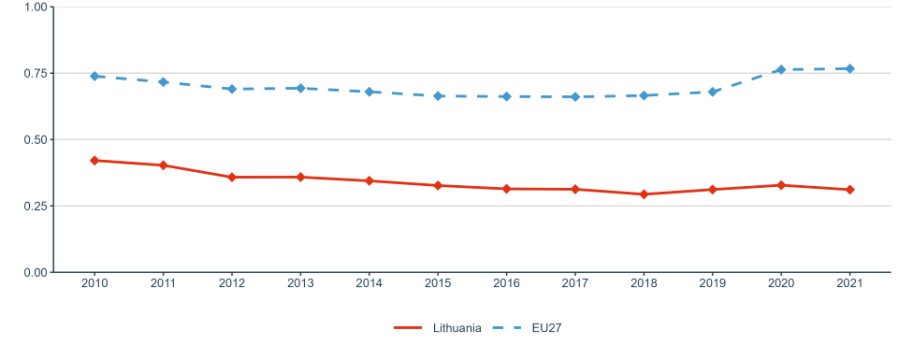

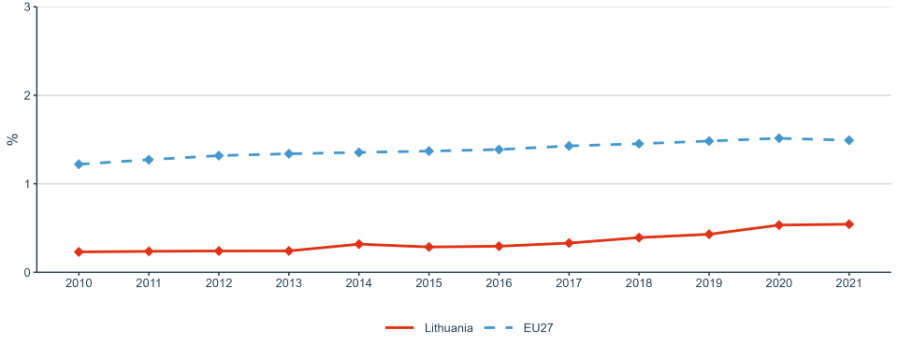
Priority 1: Deepening a truly functioning internal market for knowledge
Sub-priority 1.1: Open Science

Sub-priority 1.2: Research infrastructures

Sub-priority 1.3: Gender equality, equal opportunities for all and inclusiveness
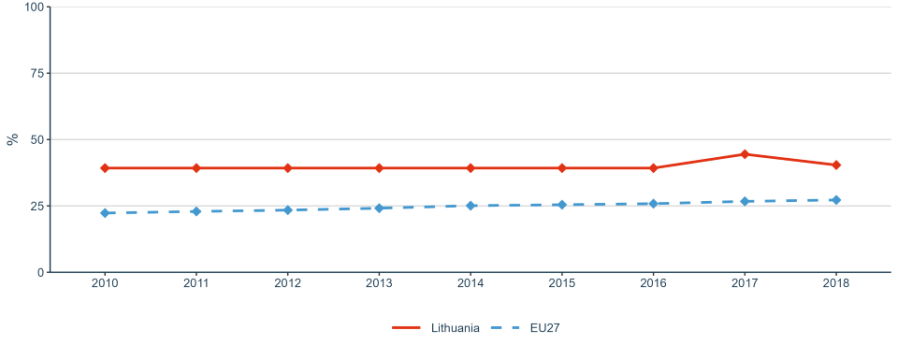
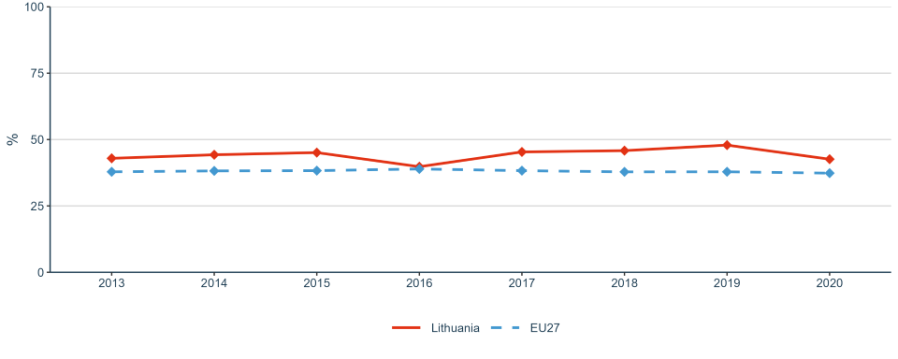

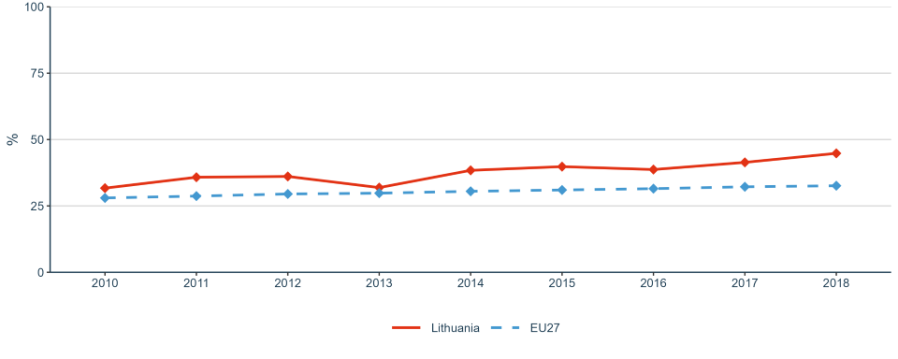

Sub-priority 1.4: Researchers’ careers and mobility and research assessment and reward systems


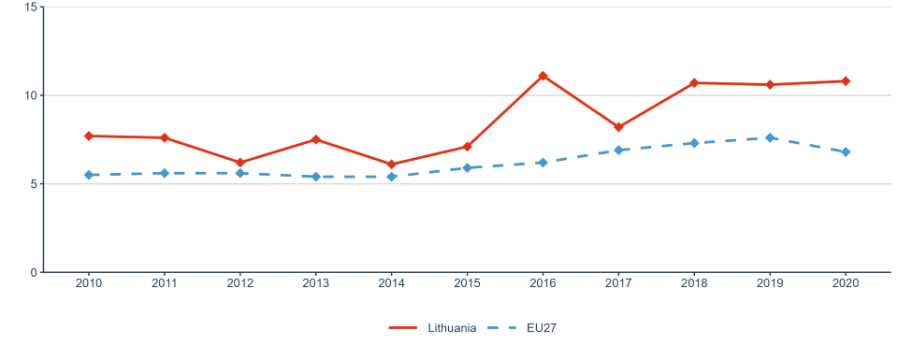
Sub-priority 1.5: Knowledge valorisation


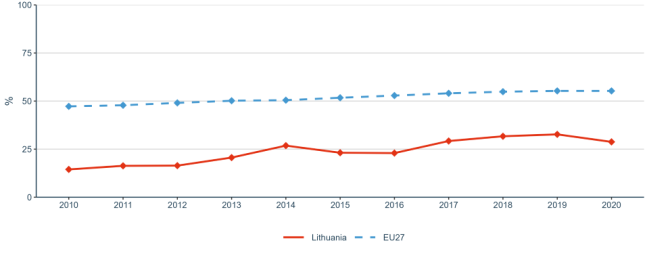


Sub-priority 1.6: Scientific leadership
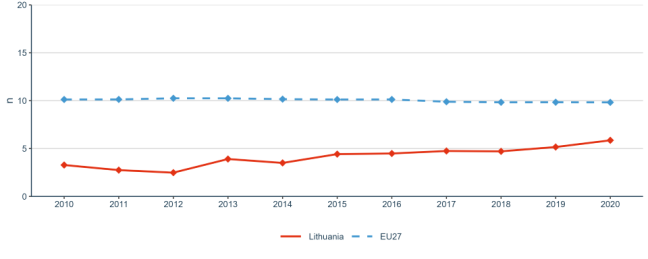

Sub-priority 1.7: Global engagement


Priority 2: Taking up together the challenges posed by the twin green and digital transition, and increasing society’s participation in the ERA
Sub-priority 2.1: Challenge-based ERA actions


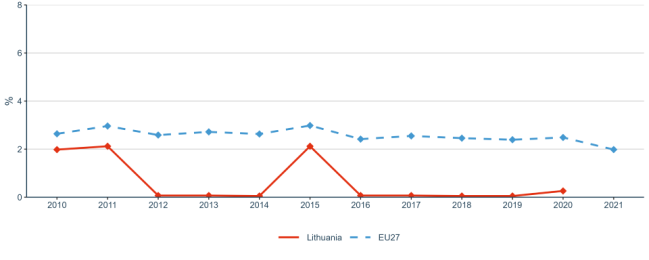
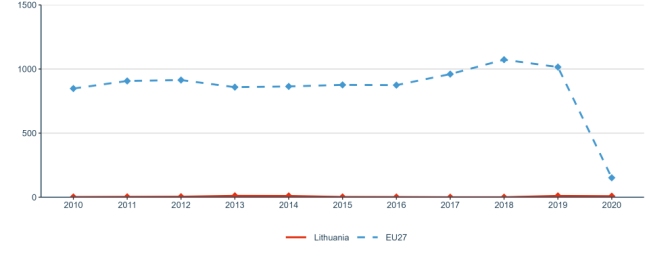

Sub-priority 2.2: Synergies with education and the European Skills Agenda
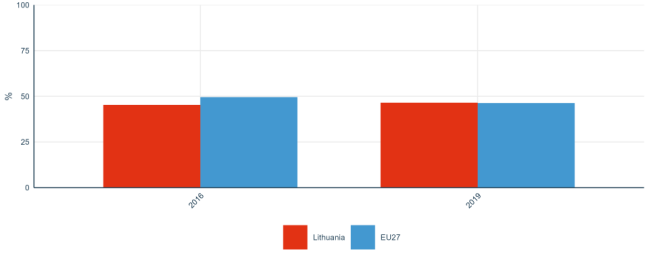
Sub-priority 2.3: Synergies with sectorial policies and industrial policy, in order to boost innovation ecosystems
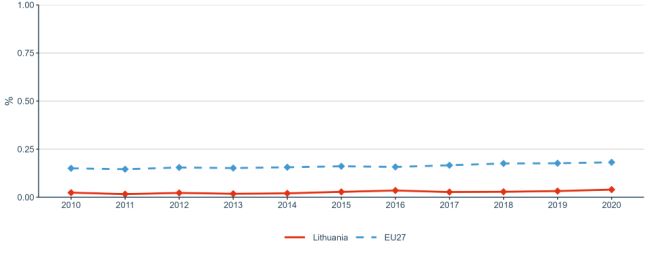
Sub-priority 2.4: An active citizen and societal engagement in R&I in all its dimensions


Priority 3: Amplifying access to research and innovation excellence across the Union
Sub-priority 3.1: More investments and reforms in countries and regions with lower R&I performance

Priority 4:Advancing concerted research and innovation investments and reforms
Sub-priority 4.1: Coordination of R&I investments

